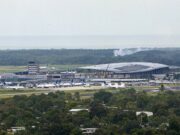
Image: © gece33 | iStockphoto
This article is the seventh in a series on landmark events in aviation since Flight Safety Foundation was founded in 1945.
For decades, approach and landing accidents (ALAs) have been among the foremost killers in aviation. The approach and landing phase of flight carries more risks than any other, with more than half of all accidents — primarily controlled flight into terrain (CFIT), loss of control–in flight (LOC-I), or runway excursions — occurring as an aircraft nears the end of its journey.
Despite dramatic declines in their numbers, ALAs are still recorded every year. Data compiled by Flight Safety Foundation’s Aviation Safety Network (ASN) shows that in 2024, there were nine fatal ALAs involving airliners and corporate aircraft (of the nine, six were jet airliners and three were turboprops) with 194 onboard fatalities and three fatalities on the ground, and in 2020–2024, there were 37 fatal ALAs involving airliners and corporate aircraft (21 jets and 16 turboprops) with 532 onboard fatalities and nine ground fatalities.
In comparison, ASN data show that 30 years earlier, in 1990–1994, airliners and corporate aircraft recorded 118 fatal ALAs (61 involving jets and 57 involving turboprops) with 3,139 onboard fatalities and seven ground fatalities.
The earliest ALAs were recorded well before jet passenger service began in the late 1950s. A 1960 report prepared for Flight Safety Foundation by Otto Kirchner of Boeing identified 437 ALAs involving air transport aircraft between 1946 and 1958 and aimed to “identify critical trends … and determine what corrective actions might lead to the reduction of accidents,” the Foundation said.1
A follow-on Foundation report examined accidents during the earliest years of the Jet Age and identified 242 ALAs from 1959 through 1963. When the report was issued in 1964, just over half of those ALAs had been analyzed and classified into categories that included runway undershoots; overshoots; flight control upsets resulting from winds or storms; “stall-outs in the vicinity of the runway threshold”; landing gear failures; “runway unsuitable,” usually because of mounds of dirt or snow; and ineffective or malfunctioning braking.
One of the earliest ALA accidents of that era occurred Feb. 3, 1959, when an American Airlines Lockheed L-188A Electra — a turboprop — undershot Runway 22 at New York’s La Guardia Airport on a foggy night, descended into the East River, and sank, killing 65 of the 73 passengers and crew. The airplane was destroyed.
In its final report on the accident, the U.S. Civil Aeronautics Board (CAB), the government body then responsible for aircraft accident investigation, identified the likely cause of the accident as “a premature descent below landing minimums” resulting from the flight crew’s “neglect of essential flight instrument references for attitude and height above the approach surface.”
The report’s recommendations called for, among other things, installation of flight recorders in all large turbine-engine aircraft, establishment of autopilot approach criteria and limitations, and creation of simulator training programs by all air carriers “prior to putting into service aircraft which require the acquisition and application of significantly different operational techniques.”
Six months after the Electra accident, an American Airlines Boeing 707 jetliner on a training flight crashed during an approach to Calverton-Peconic River Airport in New York as the pilots attempted to line up on the runway’s extended centerline. The crashed killed five crewmembers — the only people on board; the airplane was destroyed. In its final report on the accident, the CAB said the probable cause was the crew’s failure to “recognize and correct the development of excessive yaw which resulted in subsequent loss of control.”
Unlike the Electra, the 707 had a flight recorder, which the report said provided “considerable information concerning the maneuver and flight path information just prior to impact.”
The recommendations from the Electra crash, along with countless recommendations contained in other accident reports, have helped reduce the number of ALAs.
Nevertheless, the accidents were frequent, and the Foundation singled them out as one of the greatest challenges facing commercial aviation in the 1990s. In 1996, the Foundation-led Approach and Landing Accident Reduction (ALAR) Task Force was established, with members from numerous aviation organizations worldwide, including the International Civil Aviation Organization and the International Air Transport Association.
In 1999, the Foundation published “Killers in Aviation,” the Task Force’s analysis of 287 fatal ALAs that occurred between 1980 and 1996 and involved Western-built commercial jet and turboprop aircraft with a maximum takeoff weight of more than 12,500 lb/5,700 kg. The Task Force calculated that the world average was 14.8 fatal ALA accidents per year, except for nations belonging to the Commonwealth of Independent States.2 If the trend continued, the report warned, 23 fatal ALAs could be expected every year by 2010. (In 2010, according to ASN data, there were 17 fatal ALAs.)
The Task Force analysis also showed “omission of action/inappropriate action” by a member of the flight crew — most often, a continued descent below decision height or minimum descent altitude without adequate visual reference — was the most common primary causal factor, the Foundation said. The second most common primary causal factor was “lack of positional awareness in the air,” a condition that generally led to CFIT, the report said.
The report also included a more detailed study of 76 of the accidents. That smaller study said poor professional judgment/airmanship, cited in 74 percent of the ALAs, was the most frequently identified causal factor, followed by omission of action/inappropriate action (72 percent), failure in crew resource management (63.2 percent), and lack of positional awareness in air (51 percent). Other factors were cited in fewer than half of the accidents.
Key task force recommendations included improved surveillance of operators by regulatory authorities; use of terrain-awareness and warning systems, radio altimeters, and other terrain-awareness systems; enhanced training for pilots and air traffic controllers; adoption of flight data monitoring and safety programs; and installation of flight data recorders and cockpit voice recorders.
One year later, in 2000, the Foundation issued the ALAR Tool Kit, which included a risk-assessment tool and a risk-reduction guide, along with 34 ALAR Briefing Notes, which were designed to discuss recommended standard operating procedures (SOPs) for a variety of situations and associated risk assessments and accident prevention strategies.
Among the conclusions outlined in the Briefing Notes: ALA safety can be improved by adhering to adequate SOPs and decision-making processes, failure to recognize the need for a missed approach and to execute a missed approach is a major cause of ALAs, collection and analysis of in-flight data can identify trends that can be used to improve ALA safety, global information-sharing decreases the risk of ALAs, and unstabilized approaches cause ALAs.
That final point was still an issue in 2017, when the Foundation noted in its “Go-Around Decision-Making and Execution Project” that ALAs account for about 65 percent of all accidents every year and that 83 percent of them (or 54 percent of all accidents) could have been avoided if the flight crew had decided to go around.
“[T]he collective industry performance of complying with go-around policies is extremely poor — approximately 3 percent of unstable approaches result in go-round policy compliance,” the report said, adding that the norm in the industry is to “accept the noncompliance of go-around policies despite empirical data that indicate this is the most common contributor to ALAs.
Pilots’ awareness of the risks of ALAs and of their effect on approach and landing safety is low, as is the awareness of management personnel, who are “generally disengaged” from noncompliance with go-around policies, the report added.
“Why is a critical policy designed to prevent the most common type of accident ignored by flight crews, and why is that policy not being managed effectively by management?” the report asked. The document answered its own question, noting that the industry as a whole must improve its awareness of go-around noncompliance through shifts in focus and cultural norms.
The report contained multiple recommendations, including increasing awareness of the problem, as well as ensuring that the policy makes sense operationally, that it is effectively managed, and that flight crews’ situational awareness is improved throughout approach and landing.
Noncompliance is “arguably the greatest threat to flight safety today,” the report said, concluding that “the potential impact of improvement in compliance is significant. No other single decision can have such an impact in the reduction of aviation accidents as the decision to go around.”
Notes
-
Taylor, Vernon A. “Critical Factors in Approach and Landing Accidents, 1959–1963 — Interim Report.” Paper presented at Air Transport and Space Meeting, New York, April 27–30, 1964.Aircraf
-
Aircraft manufactured in the Soviet Union or the CIS often are excluded from international data analyses because of a lack of operational data.

